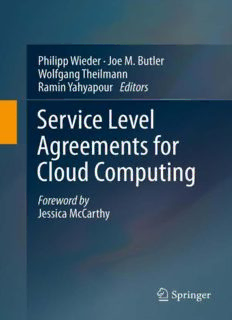Table Of ContentService Level Agreements for Cloud Computing
Philipp Wieder • Joe M. Butler
Wolfgang Theilmann • Ramin Yahyapour
Editors
Service Level Agreements
for Cloud Computing
Foreword by Jessica McCarthy
Editors
Philipp Wieder Joe M. Butler
IT & Media Center Intel Ireland Limited
Service Computing Group Leixlip, Kildare
TU Dortmund University Ireland
Dortmund
Germany
philipp.weider@udo.edu
Wolfgang Theilmann Ramin Yahyapour
SAP Research IT & Media Center
Karlsruhe Service Computing Group
Germany TU Dortmund University
Dortmund
Germany
ISBN 978-1-4614-1613-5 e-ISBN 978-1-4614-1614-2
DOI 10.1007/978-1-4614-1614-2
Springer New York Dordrecht Heidelberg London
Library of Congress Control Number: 2011939783
© Springer Science+Business Media, LLC 2011
All rights reserved. This work may not be translated or copied in whole or in part without the written
permission of the publisher (Springer Science+Business Media, LLC, 233 Spring Street, New York,
NY 10013, USA), except for brief excerpts in connection with reviews or scholarly analysis. Use in
connection with any form of information storage and retrieval, electronic adaptation, computer software,
or by similar or dissimilar methodology now known or hereafter developed is forbidden.
The use in this publication of trade names, trademarks, service marks, and similar terms, even if they are
not identified as such, is not to be taken as an expression of opinion as to whether or not they are subject
to proprietary rights.
Printed on acid-free paper
Springer is part of Springer Science+Business Media (www.springer.com)
TheSLA@SOIprojectisdedicatedtoprovide
abusiness-readyservice-oriented
infrastructureempoweringtheservice
economyinaflexibleanddependableway.
Foreword
SLA@SOI is one of the most significant projects funded under the European
Union’s Seventh Framework Programme. With a budget of over 15 million Eu-
rosandaconsortiumoftwelvepartners,SLA@SOIisacomprehensiveintegrated
project of broad scope, touching market segments in areas including management
of service level agreements (SLAs), service-oriented infrastructures (SOIs), cloud
computing,enterpriseservicebusesandXaaSprovisioning(includingPlatformasa
Service,SoftwareasaService,InfrastructureasaService,etc).Relevantinitiatives
includeglobal-scalecommercialofferings,well-supportedopensourceprojects,and
large,strategicpublicly-fundedresearchinitiatives.
SLA@SOIoperateswithinhighlydynamicandfast-movingdomains,andmany
world-classplayersareveryactiveinareasinwhichSLA@SOIcanmakemostim-
pact,namelycloudcomputingandservice-orientedarchitectures.WeinSLA@SOI
believethatSLAsareakeytechnologyfortransformingserviceandcloudofferings
intotradeablegoods.Theprojecthasinvestedthreeyearsofin-depthresearchand
analysisintotheSLAdomain,developingacomprehensivearchitectureandrefer-
enceimplementationforSLAmanagement,thenevaluatingandincorporatingthese
resultsinfourdistinctandcomplementaryindustrialusecases.
Specifically,theSLA@SOIprojectaimstoenableautomaticnegotiationofper-
sonalisedSLAsacrossmultipleproviders,suchthatindividualSLAsforthousands
ofcustomerscanbeautomaticallymanagedandoptimised.Mostindustrialservice
providershavenotyetcometotermswiththisnotionofprovidingautomatedSLAs
withtheirserviceofferings,whichisverypromisingfromSLA@SOI’sperspective.
Currently, market leaders still rely on highly manual processes for making claims
onSLAviolations.
Machine-readableSLAs,ontheotherhand,willallowconsumersandproviders
of online services to precisely specify the services and service levels they require,
confirmthatSLAsarebeingmet,andautomaticallydealwithanySLAviolations.
SLA@SOIprovidesaframeworkunderwhichautomaticSLAnegotiationandSLA-
awareoptimisationbecomefeasible.Machine-readableSLAsallowservicelevelsto
bepersonalised,automaticallynegotiated,aggregated,andcontinuouslyassured.
vii
viii Foreword
ThebookpresentsauniqueinsightintotheSLA@SOIproject,withafocuson
reference architectures, open reference case examples, SLA models, service con-
struction meta-models, and approaches to infrastructure monitoring and runtime
prediction. The book also recounts the results of four SLA@SOI use cases—in e-
government,Telcoserviceaggregation,ERPhosting,andenterpriseIT—analysing
outcomesfromabusinessandtechnicalresearchperspective.
As exploitation manager for SLA@SOI, I have observed firsthand the interest
this research project has generated from both industry and academia. The project
is differentiated from other commercial and research offerings in that it has an
SLA-drivenapproachthatconsidersarangeofstakeholders(e.g.serviceproviders,
softwareproviders,infrastructureprovidersandservicecustomers)whileexplicitly
tackling challenges at the business, software and infrastructure levels. SLA@SOI
aims to provide an automated and holistic awareness of personalised SLAs along-
sideabusiness-readySOIthatempowerstheserviceeconomyandFutureInternet
inaflexibleanddependableway.
By defining a cohesive research agenda for Europe going forward, the Future
Internet initiative will provide important medium- and long-term opportunities for
exploitationofSLA@SOI.
Dublin,June2011 JessicaMcCarthy
Preface
IT-supportedserviceprovisioningisofmajorrelevanceforalmostallindustriesand
IT domains. And with the evolution of ecosystems where everything can become
a service and the actual IT provisioning is virtualized, the importance of service-
related infrastructures will further increase. The so-called clouds already have the
buyinfromindustry,resultingintermslikeeverything-as-a-service,scaleout,multi
tenancy, and pay-as-you-go become increasingly popular to describe this new ap-
proach,showingontheonehandthebusinessmodelbehindthecloudofferingsand
on the other hand underlining its commercial character. From a research perspec-
tive,thissomehowyoungdisciplineoffersalargevarietyoftopicsandnoveltopics
willcertainlyemerge.
The research project SLA@SOI (funded under the Seventh Framework Pro-
grammewithgrantnumberFP7-216556)providesamajormilestoneforthefurther
evolutiontowardsaservice-orientedeconomy,whereIT-basedservicescanbeflex-
ibly traded as economic good, i.e. under well-defined and dependable conditions
andwithclearlyassociatedcosts.Eventually,thiswillallowfordynamicvaluenet-
worksthatcanbeflexiblyinstantiatedthusdrivinginnovationandcompetitiveness.
SLA@SOIcreatedaholisticviewforthemanagementofservicelevelagreements
(SLAs)andprovidesanSLAmanagementframeworkthatcanbeeasilyintegrated
intoaservice-orientedinfrastructure.
Europe has set high goals in becoming the most active and productive service
economy in the world. Especially IT supported services evolved into a common
utility which is offered and consumed by many stakeholders. Cloud computing
gainedsignificantattentionandcommercialuptakeinmanybusinessscenarios.This
rapidly growing service oriented economy has highlighted key challenges and op-
portunitiesinIT-supportedserviceprovisioning.Withmorecompaniesincorporat-
ing cloud-based IT services as part of their own value chain, reliability and de-
pendabilitybecomeacrucialfactorinmanagingbusiness.Servicelevelagreements
arethecommonmeanstoprovidethenecessarytransparencybetweenservicecon-
sumersandproviders.
SLA@SOIasamajorEuropeanprojectaddressestheissuessurroundingtheim-
plementationofautomatedSLAmanagementsolutionsforserviceorientedinfras-
ix
Description:Service Level Agreements for Cloud Computing provides a unique combination of business-driven application scenarios and advanced research in the area of service-level agreements for Clouds and service-oriented infrastructures. Current state-of-the-art research findings are presented in this book, as

